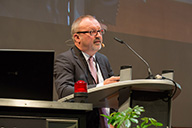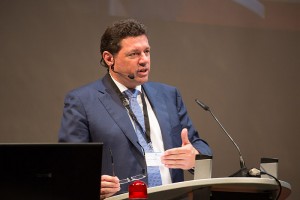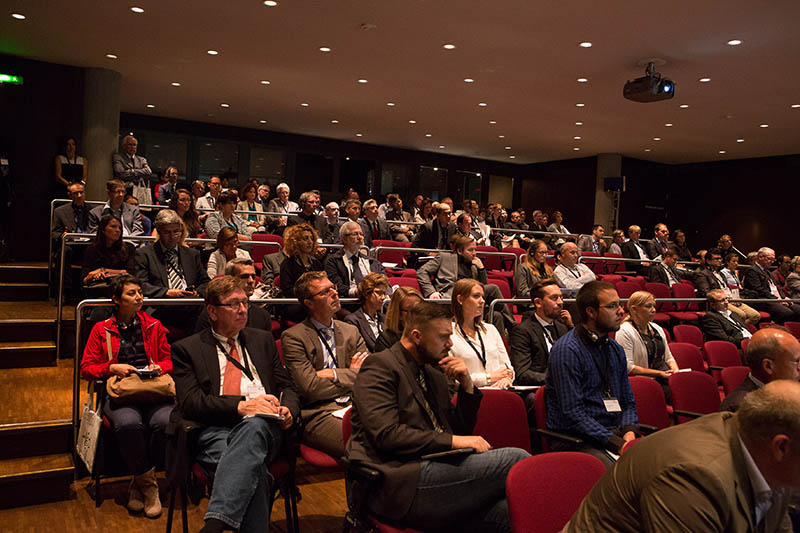Europe’s manmade fiber industry leaders have called on their Chinese counterparts to base future investment decisions on rational economics and reduce senseless overcapacities, especially in polyester fibers.
Addressing the 54th Dornbirn Man-Made Fibers Congress held in Dornbirn, Austria, in September, Heinz Meierkord, president of CIRFS, the European Man-Made Fibres Association, described how Chinese overcapacity represented 25% of global polyester fiber capacity in 2015.
The growing surplus is leading to massive selling in export markets at low prices, causing distortions and damage to these markets, he said.

Meierkord, chief executive officer of Advansa, noted that global fiber production in 2014 amounted to 92.7 million tons, of which 71% were manmade fibers that continue to dominate the market, especially polyester, which accounts for 74% of global man-made fiber production.
As the second largest regional producer of manmade fibers, Europe has a more balanced spread of fibers manufactured than the market leader, China, which has 66% of global manmade fiber capacities, including 73% of global polyester fiber capacities.
However, when dumping fibers onto the market at below cost is used as a basis for investment decisions, this is “unsustainable and will ultimately lead to bankruptcies,” said Meierkord.
“The fiber industry should demand responsible behavior from major players, especially the Chinese, who may not be making decisions based on sound economic calculations.
“If you do not create profits, you do not create value. If the Chinese manmade fiber industry is not creating value, it will not be capable of sustaining wealth and jobs.
“Add to this the environmental impact of producing fibers that the world does not need then the conclusion is that this cannot continue.”
Same challenges

Opening the congress, Robert van de Kerkhof, president of the Austrian Man-Made Fibers Institute and chief operating officer of Lenzing, noted that the fiber industry is still facing the same challenges as a year ago: a difficult business environment, increasing geopolitical tensions, structural problems in the global economy and an ongoing lack of solutions for tackling environmental problems.
Despite the current problems in its economy, China still represents a significant growth market. And with more people living in urban areas, fiber usage per capita continues to rise, especially in developing countries, and global fiber demand will soon exceed 100 million tons.
However, limited resources in water, land, air and energy will be a major challenge for the fiber industry, said van de Kerkhof.
While politics will dominate the regulatory market, consumer behavior will become even more important. “There is a trend toward ethical consumption and higher consumer awareness,” he said. “Eco-fibers will increase in demand and there is the rise of green fashion.
“There is very little we can do [on a macro level], but we have to drive innovation in how we do business; for example, doing more with less, especially in terms of fiber recycling. This will mean developing new products and more efficient technologies to solve the problems of the future.”
Global brand
Over the past few years the Dornbirn Man-Made Fibers Congress has been trying to develop a global brand: this year the event attracted more than 700 participants from 32 countries with some 70% of delegates from Europe.
The congress also featured a total of 106 lectures covering a broad range of topics from fibers through to end-uses. Around 60% of the presentations were from research institutes and universities, with the remainder from industry.
With sustainability the underlying theme, the main topics of this year’s conference were: fiber/filament innovations in (bio-) polymers; functionalization and adaptation of fibers and surfaces; nonwovens/filtration; environment and health; and advanced fiber and processing technology.
During the opening of the congress, the Paul Schlack/Wilhelm Albrecht Award 2015 was presented to Dr. Wilhelm Steinmann of the Institut für Textiltechnik der RWTH Aachen, Germany, for his work on electrically conductive fibers from nanocomposites.
The Honorary Award went to Dr. Klaus Opwis of the Deutsches Textilforschungszentrum Nord-West Krefeld, Germany, for his work on innovative textiles for the recovery of noble metals.
The plenary session included a lecture on innovative supporting frameworks and building shells by Gerd Schmid of Form TL, Ingenieure für Tragwerk und Leichtbau, Germany, who outlined visionary designs covering issues such as building physics, statics and sustainability, as well as shapes, colors and light effects.
Franziska Hesser of Wood K plus, the Competence Center for Wood Composites and Wood Chemistry, Austria, discussed forests, wood and fibers from the angle of sustainability and communication, including a holistic approach to life-cycle analysis.
Meanwhile, a thought-provoking paper by Thomas Macho of Humboldt Universität zu Berlin, Germany, threw a new – and different – light on economics and economic activity.
Fiber innovations
The presentations on fiber innovations continue to provide the core of the Dornbirn program. In a congress dominated by polyester and cellulosic fibers, it was encouraging to see several papers focused on the use of bio-based polyamide (PA).
Kazue Ueda of Unitika, Japan, explained the development of the company’s Xecot high heat-resistant bio-PA for automotive applications as well as parts for electronic devices. Made from biomass (56%), Xecot offers high melting and glass transition temperatures, low water absorption and high crystallinity.
Andreas Flachenecker of PHP Fibers, Germany, discussed bio-based PA polymers for high-tenacity yarn production. These polymers are currently based on sebacic (dicarboxylic) acid, which is derived from the castor oil plant.
In spinning trials, the company examined bio-PA4.10, bio-PA6.10 and bio-PA10.10 compared with PA6.6 and PA6 as reference yarns.
Bio-PA4.10 was shown to have similar physical properties for yarn (235 dtex) and polymer as the reference yarns, particularly in terms of melting temperature and glass transition temperature.
In addition, bio-based PA4.10 polymer has lower humidity pick-up (increased dimensional stability), lower density and the lowest global warming potential.
A yarn/cord bio-based PA4.10 met all the tenacity requirements of PA6.6. Further, it had a higher modulus and good adhesion to rubber.
Flachenecker concluded that technical yarns made from bio-based PA4.10 polymer can be considered as sustainable and equivalent alternative for yarns made from fossil-based PA6.6 polymer.
Super imitation cotton
Alex Kedo of Cathay Industrial Biotech, China, presented what was described as an innovative, cost-effective, bi-based PA for textiles.
Part of the company’s PA5X range, Terryl PA5.6 comprises 45% bio-based material. It has a lower density than polyethylene terephthalate (PET) or polytrimethylene terephthalate (PPT), comparable strength to PA6 and PA6.6, and higher elastic recovery than PET, PA6.6 and PA6.
Further, the lower viscosity of Terryl at high sheer than PA6.6 allows for easier spinning, and its higher moisture absorbance and wicking behavior provides increased comfort than these other synthetic fibers. Dyeing performance is also improved and it is inherently flame retardant (FR).
Kedo noted that U.S. Army and NATO uniforms comprise 50% PA6.6/50% cotton; however, the uniforms for China’s two million-strong military are made of polyester, which leads to lower comfort and poor wearability.
The Chinese army has received funding for a trial of uniforms made from 20,000 tons of Terryl; Cathay Industrial Biotech will provide the aromatic polyamide salt and polymerization technology.
With excess polyester spinning capacity in China and cotton generally in short supply across Asia, China is also looking at ways of utilizing polyester with a cotton-replacement polymer to improve fabric feel and performance as part of a national “super imitation cotton program.”
The similar melting points of PET and PA5.6 enable blending, co-spinning and co-polymerization of these polymers, and Cathay is looking at adding 15% Terryl to polyester to reduce the water contact angle in the resulting fabric owing to the presence of a covalent bond in the PA.
With a production site in the Jining Chemical Development Zone in southwestern Shandong province, the company is now looking to expand into North America, Kedo revealed.
Viscose specialties
Among a total of five lectures at Dornbirn by viscose specialty manufacturer Kelheim Fibres of Germany, Dr. Philipp Wimmer showed how the combination of biopolymers could create new composite materials in which the beneficial properties of all components can equally coexist. This can enable new applications, for example in the field of medical products, he noted.
As viscose fibers can be used as a precursor for the production of carbon fibers, Dr. Roland Scholz explained how the carbonization of viscose fibers of different shapes and sizes and with various functionalized additives extends the scope of possible structures and properties of carbon fibers and offers the potential for new fields of application.
Dr. Ingo Bernt described viscose fibers with inorganic content, in particular Kelheim’s Danufil BF fiber, where a modified spinning dope ensures an extremely homogenous distribution of the silica network. This produces a fiber with FR properties, without the need for further FR additives.
Tencel/wool blend fabric
Meanwhile, presentations from Austria-based cellulosic fiber supplier Lenzing included the use of Tencel fibers for hygiene, wet wipes, wet-laid processes and footwear.
With the trend toward lightweight fabrics based on finer yarns, Andreas Gürtler disclosed work on a blend of 70% Tencel A100 and wool, which he said offers better cooling, better wicking and moisture management properties, and higher comfort (less itching) than 100% wool fabric.
Savings in dyeing and finishing are also claimed owing to the excellent color uptake of Tencel A100 and, therefore, less wastewater generated.
Martin Gebert-Germ of Glanzstoff Industries, Austria, outlined a continuous shrinkage process for high-tenacity viscose multifilament yarns. The company’s preshrunk Viscont yarns can be used in weaving processes to fulfill dimensional stability standards, such as EN ISO 11611 and EN ISO 11612, he said.
Next year’s congress
The 55th Dornbirn Man-Made Fibers Congress will take place from September 20-22, 2016, with a change to a Tuesday to Thursday format.
The main themes proposed are: fiber developments (sustainability); fibers and textiles in the automotive industry; finishing and functional additives (smart textiles, sensors, monitoring); fibers for nonwovens; and fibers for medical and protective applications.
For the next conference, EDANA, the International Association for the Nonwovens and Related Industries, will act as a sponsor for nonwovens and automotive applications.
Pierre Wiertz, general manager, said EDANA is looking forward to cooperating with the Dornbirn event, since innovations in the fiber sector are key to the nonwovens industry and the congress is a strong partner that supports industry in the field of innovation.
This partnership between two the European-based organizations with similar objectives is likely to be continued every two years, he added.
Meanwhile, the congress organizers, headed by Program Committee Chairman Friedrich Weninger, are promoting the concept of an “innovation community”, which aims to enhance interactivity between participants and lecturers and to make the best possible use of a “think tank” of researchers and technologists. This should give rise to the use of modern communication instruments and social networks.
Weninger is also looking for more involvement from chemical suppliers and equipment manufacturers, as well as the natural fiber industry; however, the focus will continue to remain on Europe.
The congress is now being organized along the guidelines of the Austrian eco-label for “green meetings and green events.” Most products provided by the caterers were sourced from within a radius of 150 km from Dornbirn, which is described as Austria’s “smartest” city in terms of quality of life, business-friendly attitude, innovative energy, transport and traffic planning, and energy efficiency.
For more information visit: www.dornbirn-mfc.com


